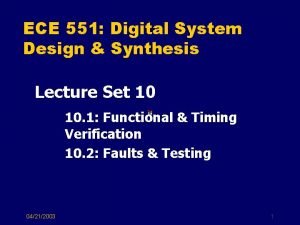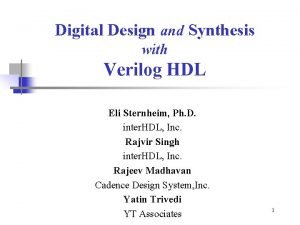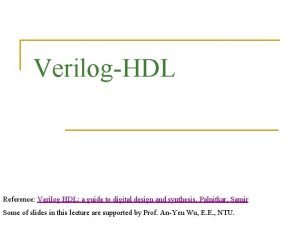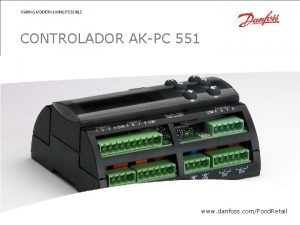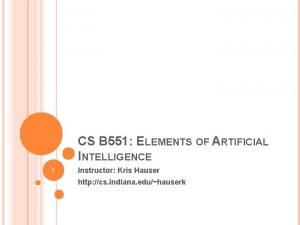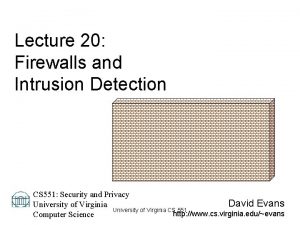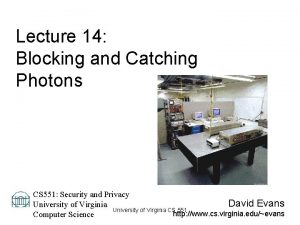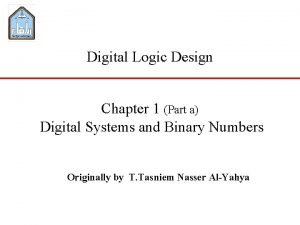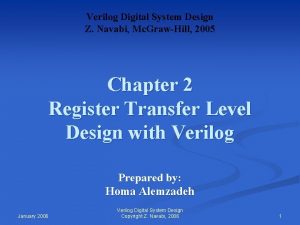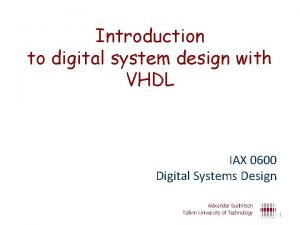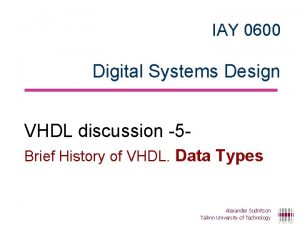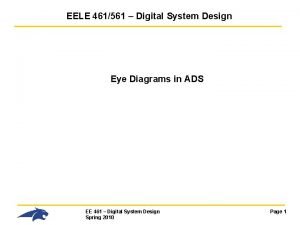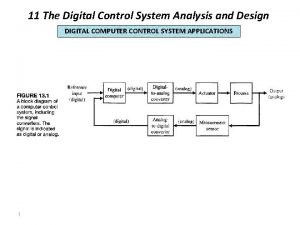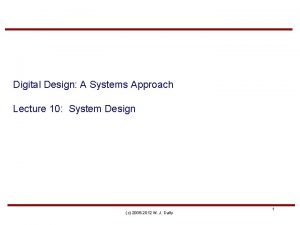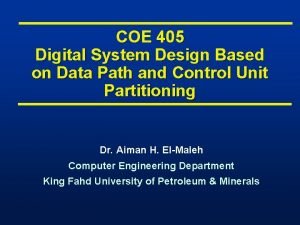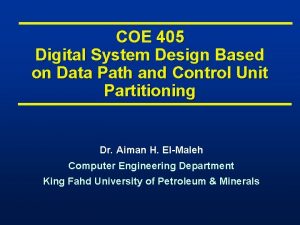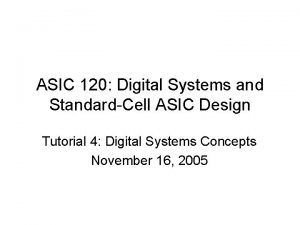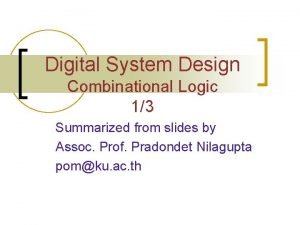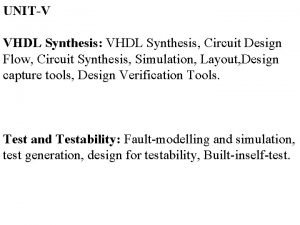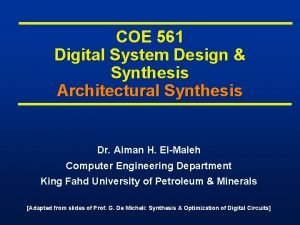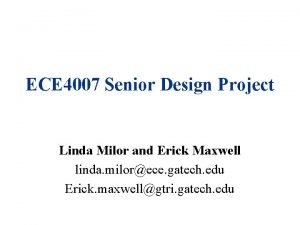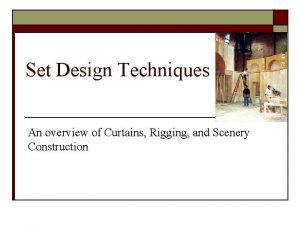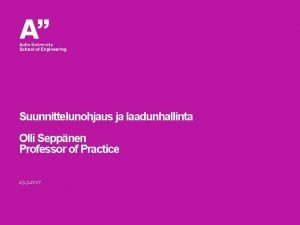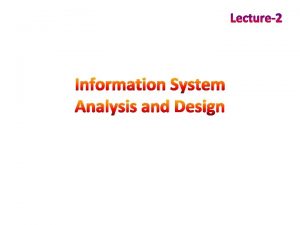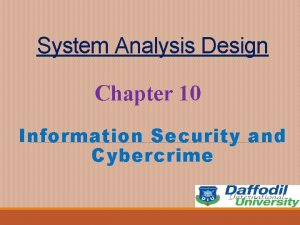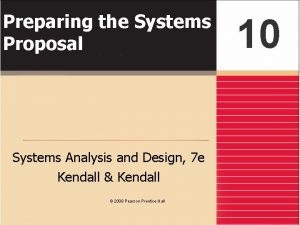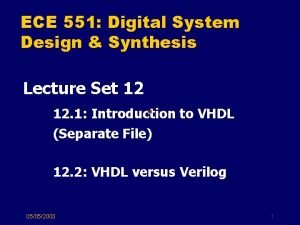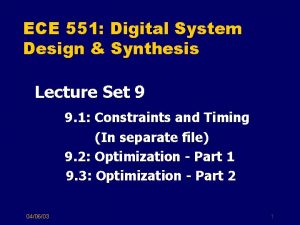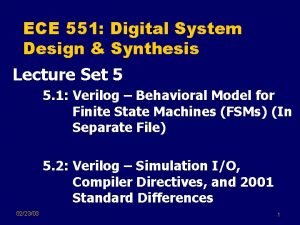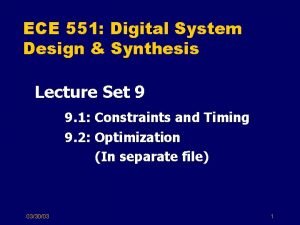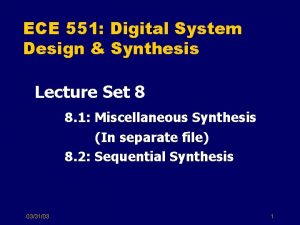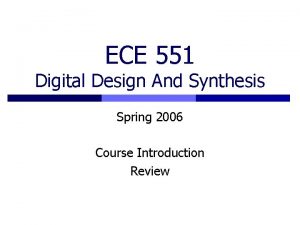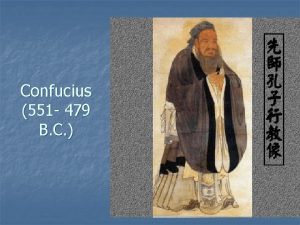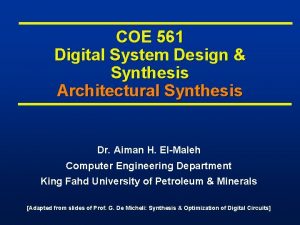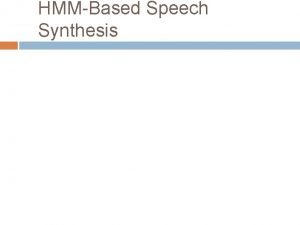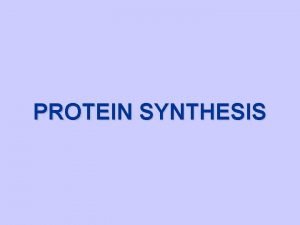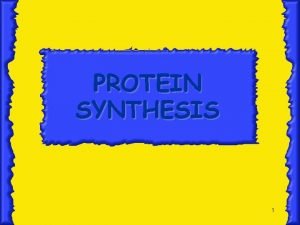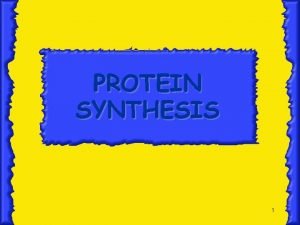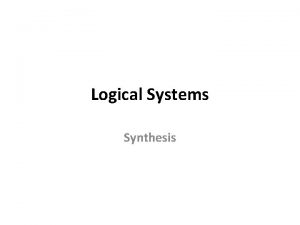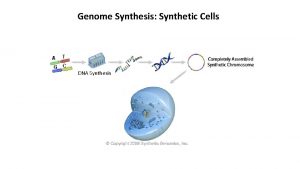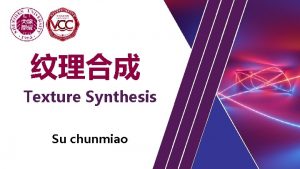ECE 551 Digital System Design Synthesis Lecture Set



































































- Slides: 67

ECE 551: Digital System Design & Synthesis Lecture Set 10 10. 1: Functional & Timing Verification (Separate File) 10. 2: Faults & Testing 10. 2 Appendix: PODEM Example Slides adapted from ECE 553 Slides by Prof. Kewal Saluja 04/23/2003 1

ECE 551 - Digital System Design & Synthesis Lecture 10. 2 – Faults and Testing Overview Introduction q Fault Models q Test Pattern Generation q Design for Testability (DFT) – Serial Scan q Built-In Self-Test (BIST) q Boundary Scan (JTAG/IEEE 1149. 1) q Quiescent Drain Current (IDDQ) Testing q 04/23/2003 2

Introduction The manufacturing process for ICs is so complex that only a portion of all chips produced are good – the percentage of such good chips is referred to as the yield q In order to avoid shipping defective products, manufacturing test at the die and packaged chip level is required. q Complex chips => complex tests q q The objective: summary the elements of contemporary IC test 04/23/2003 3

Overview Introduction q Fault Models q Test Pattern Generation q Design for Testability (DFT) – Serial Scan q Built-In Self-Test (BIST) q Boundary Scan (JTAG/IEEE 1149. 1) q Quiescent Drain Current (IDDQ) Testing q 04/23/2003 4

Common Fault Models Single stuck-at faults q Transistor open and short faults q Memory faults q PLA faults (stuck-at, cross-point, bridging) q Functional faults (processors) q Delay faults (transition, path) q Analog faults q 04/23/2003 5

Stuck-at Faults • Single stuck-at fault model • What does it achieve in practice? • Fault equivalence • Checkpoint faults 04/23/2003 6

Single Stuck-at Fault q Three properties define a single stuck-at fault • Only one line is faulty • The faulty line is permanently set to 0 or 1 • The fault can be at an input or output of a gate q Example: XOR circuit has 12 fault sites ( ) and 24 single stuck-at faults Faulty circuit value c 1 0 a d b e f Good circuit value j s-a-0 g 1 0(1) 1(0) h i k z 1 Test vector for h s-a-0 fault 04/23/2003 7

Single Stuck-at Faults (contd. ) q. How effective is this model? § Empirical evidence supports the use of this model § Has been found to be effective to detect other types of faults § Relates to yield modeling § Simple to use 04/23/2003 8

Fault Equivalence Number of fault sites in a Boolean gate circuit = #PI + #gates + # (fanout branches). q Fault equivalence: Two faults f 1 and f 2 are equivalent if all tests that detect f 1 also detect f 2. q If faults f 1 and f 2 are equivalent then the corresponding faulty functions are identical. q Fault collapsing: All single faults of a logic circuit can be divided into disjoint equivalence subsets, where all faults in a subset are mutually equivalent. A collapsed fault set contains one fault from each equivalence subset. q 04/23/2003 9

Equivalence Example sa 0 sa 1 sa 0 sa 1 04/23/2003 sa 0 sa 1 sa 0 sa 1 Faults in blue removed by equivalence collapsing sa 0 sa 1 20 Collapse ratio = ----- = 0. 625 32 10

Checkpoints Primary inputs and fanout branches of a combinational circuit are called checkpoints. q Checkpoint theorem: A test set that detects all single (multiple) stuck-at faults on all checkpoints of a combinational circuit, also detects all single (multiple) stuck-at faults in that circuit. q Total fault sites = 16 Checkpoints ( ) = 10 04/23/2003 11

Summary q q q Gate level models are most prevalent in logic testing Fault models are analyzable approximations of defects and are essential for a test methodology. For digital logic single stuck-at fault model offers advantage of effective tools and much experience. Many other faults (bridging, stuck-open and multiple stuck-at) are largely covered by stuck-at fault tests. Stuck-short and delay faults and technology-dependent faults require special tests. Memory and analog circuits need other specialized fault models and tests. 04/23/2003 12

Overview Introduction q Fault Models q Test Pattern Generation q Design for Testability (DFT) – Serial Scan q Built-In Self-Test (BIST) q Boundary Scan (JTAG/IEEE 1149. 1) q Quiescent Drain Current (IDDQ) Testing q 04/23/2003 13

Definition of Automatic Test-Pattern Generator q Operations on digital hardware: § Inject fault into sequential circuit modeled in computer § Use various ways to activate and propagate fault effect through hardware to circuit output § Output flips from expected to faulty signal q Scan design – add test hardware to all flipflops to make them a giant shift register in test mode § Can shift state in, scan state out § Widely used – makes sequential circuit into combinational circuit for testing! § Costs: 5 to 20% chip area, circuit delay, extra pin, longer test sequence 04/23/2003 14

Notation Failing Good Meaning Machine Symbol D D 0 1 X 04/23/2003 1/0 0/1 0/0 1/1 X/X 1 0 0 1 X Roth’s D Algebra 15

Conditions for Finding a Test Fault excitation – the signal value at the fault site must be different from the value of the stuck-at fault (thus fault site must contain a D or a D) q The fault effect must be propagated to a primary output (A D or a D must appear at the output) q Some simple observations q § There must be at least a D or a D on some circuit nets) § D’s must form a chain to some output 04/23/2003 16

Exhaustive Algorithm For n-input circuit, generate all 2 n input patterns q Infeasible, unless circuit is partitioned into cones of logic, with 15 inputs q § Perform exhaustive ATPG for each cone § Misses faults that require specific activation patterns for multiple cones to be tested 04/23/2003 17

Random-Pattern Generation Flow chart for method q Use to get tests for 6080% of faults, then switch to Dalgorithm or other ATPG for rest q 04/23/2003 18

Path Sensitization Method Example 1 Fault Sensitization 2 Fault Propagation 3 Line Justification 04/23/2003 19

Path Sensitization Method Example § Try path f – h – k – L. This path is blocked at j, since there is no way to justify the 1 on i 1 1 D D 1 04/23/2003 20

Path Sensitization Method § Try simultaneous paths f – h – k – L and g – i – j – k – L. These paths blocked at k because D-frontier (chain of D or D) disappears 1 1 D D D 1 04/23/2003 21

Path Sensitization Method Circuit Example § Final try: path g – i – j – k – L – test found! 0 1 0 D D D 1 1 04/23/2003 22

Overview Major ATPG algorithms • Definitions • D-Algorithm (Roth) – 1964 -66 – D-cubes – Bridging faults – Logic gate function change faults • PODEM (Goel) -- 1981 – X-Path-Check – Backtracing • Summary 04/23/2003 23

Overview Introduction q Fault Models q Test Pattern Generation q Design for Testability (DFT) – Serial Scan q Built-In Self-Test (BIST) q Boundary Scan (JTAG/IEEE 1149. 1) q Quiescent Drain Current (IDDQ) Testing q 04/23/2003 24

Definition q Design for testability (DFT) refers to those design techniques that make test generation and test application cost-effective. q DFT methods for digital circuits: § Ad-hoc methods § Structured methods: • • 04/23/2003 Scan Partial Scan Built-in self-test (BIST) Boundary scan 25

Scan Design § Objectives • Simple read/write access to all or subset of storage elements in a design. • Direct control of storage elements to an arbitrary value (0 or 1). • Direct observation of the state of storage elements and hence the internal state of the circuit. Key is – Enhanced controllability and observability. 04/23/2003 26

Scan Design § Circuit is designed using pre-specified design rules. § Test structure (hardware) is added to the verified design: • Add one (or more) test control (TC) primary input. • Replace flip-flops by scan flip-flops and connect to form one or more shift registers in the test mode. • Make input/output of each scan shift register controllable/observable from PI/PO. § Use combinational ATPG to obtain tests for all testable faults in the combinational logic. § Add shift register tests and convert ATPG tests into scan sequences for use in manufacturing test. 04/23/2003 27

Scan Flip-Flop (masterslave) Master latch D Slave latch TC Q Logic overhead MUX SD CK Q D flip-flop CK TC 04/23/2003 Master open Slave open Normal mode, D selected t Scan mode, SD selected t 28

Adding Scan Structure PI PO Combinational SFF logic SFF SCANOUT SFF TC or TCK SCANIN 04/23/2003 Not shown: CK or MCK/SCK feed all SFFs (scan Flipflops). 29

Comb. Test Vectors PI I 1 I 2 04/23/2003 O 2 Combinational SCANIN TC Present state O 1 SCANOUT logic S 1 S 2 PO N 1 N 2 Next state 30

Comb. Test Vectors SCANIN I 2 I 1 PI S 1 Don’t care or random bits S 2 TC 0 0 0 0 1 0 0 0 0 PO SCANOUT O 2 O 1 N 2 Sequence length = (nsff + 1) ncomb + nsff clock periods ncomb = number of combinational vectors nsff = number of scan flip-flops 04/23/2003 31

Scan Overhead IO pins: One pin necessary. q Area overhead: q § Gate overhead = [4 nsff/(ng+10 nff)] x 100%, where ng = comb. gates; nff = flip-flops; • Example – ng = 100 k gates, nff = 2 k flip-flops, overhead = 6. 7%. § More accurate estimate must consider scan wiring and layout area. q Performance overhead: § Multiplexer delay added in combinational path; approx. two gate-delays. § Flip-flop output loading due to one additional fanout; approx. 5 -6%. 04/23/2003 32

Overview Introduction q Fault Models q Test Pattern Generation q Design for Testability (DFT) – Serial Scan q Built-In Self-Test (BIST) q Boundary Scan (JTAG/IEEE 1149. 1) q Quiescent Drain Current (IDDQ) Testing q 04/23/2003 33

BIST Process q q Test controller – Hardware that activates self-test simultaneously on all PCBs Each board controller activates parallel chip BIST Diagnosis effective only if very high fault coverage 04/23/2003 34

BIST Architecture q Note: BIST cannot test wires and transistors: § From PI pins to Input MUX § From POs to output pins 04/23/2003 35

Pattern Generation q Store in ROM – too expensive Exhaustive q Pseudo-exhaustive q Pseudo-random (LFSR) – Preferred q method q Binary counters – use more hardware than LFSR q Modified counters q Test pattern augmentation § LFSR combined with a few patterns in ROM § Hardware diffracter – generates pattern cluster in neighborhood of pattern stored in 04/23/2003 ROM 36

Exhaustive Pattern Generation (A Counter) q q q Shows that every state and transition works For n-input circuits, requires all 2 n vectors Impractical for large n ( > 20 ) 04/23/2003 37

Random Pattern Testing Bottom: Random. Pattern Resistant circuit 04/23/2003 38

Pseudo-Random Pattern Generation q Standard Linear Feedback Shift Register (LFSR) § Normally known as External XOR type LFSR § Produces patterns algorithmically – repeatable § Has most of desirable random # properties q Need not cover all 2 n input combinations q Long sequences needed for good fault coverage 04/23/2003 39

Test Pattern Augmentation q Secondary ROM – to get LFSR to 100% SAF coverage § Add a small ROM with missing test patterns § Add extra circuit mode to Input MUX – shift to ROM patterns after LFSR done § Important to compact extra test patterns q Use diffracter: § Generates cluster of patterns in neighborhood of stored ROM pattern Transform LFSR patterns into new vector set q Put LFSR and transformation hardware in full-scan chain 04/23/2003 40 q

Response Compaction q Severe amounts of data in CUT response to LFSR patterns – example: § Generate 5 million random patterns § CUT has 200 outputs § Leads to: 5 million x 200 = 1 billion bits response Not economical to store and check all of these responses on chip q Responses must be compacted q 04/23/2003 41

Definitions q q Aliasing – Due to information loss, signatures of good and some bad machines match Compaction – Drastically reduce # bits in original circuit response – lose information Compression – Reduce # bits in original circuit response – no information loss – fully invertible (can get back original response) Signature analysis – Compact good machine response into good machine signature. Actual signature generated during testing, and compared with good machine signature 04/23/2003 42

LFSR for Response Compaction q q q Use cyclic redundancy check code (CRCC) generator (LFSR) for response compacter Treat data bits from circuit POs to be compacted as a decreasing order coefficient polynomial CRCC divides the PO polynomial by its characteristic polynomial § Leaves remainder of division in LFSR § Must initialize LFSR to seed value (usually 0) before testing q q After testing – compare signature in LFSR to known good machine signature Critical: Must compute good machine signature 04/23/2003 43

Example Modular LFSR Response Compacter q 04/23/2003 LFSR seed value is “ 00000” 44

Summary LFSR pattern generator and MISR response compacter – preferred BIST methods q BIST has overheads: test controller, extra circuit delay, Input MUX, pattern generator, response compacter, DFT to initialize circuit & test the test hardware q BIST benefits: q § § § At-speed testing for delay & stuck-at faults Drastic ATE cost reduction Field test capability Faster diagnosis during system test Less effort to design testing process Shorter test application times 04/23/2003 45

Overview Introduction q Fault Models q Test Pattern Generation q Design for Testability (DFT) – Serial Scan q Built-In Self-Test (BIST) q Boundary Scan (JTAG/IEEE 1149. 1) q Quiescent Drain Current (IDDQ) Testing q 04/23/2003 46

Overview: Boundary Scan Motivation q System view of boundary scan hardware q Elementary scan cell q Test Access Port (TAP) controller q Boundary scan instructions q Summary q 04/23/2003 47

Motivation for Standard n Bed-of-nails printed circuit board tester gone § We put components on both sides of PCB & replaced DIPs with flat packs to reduce inductance n Nails would hit components § Reduced spacing between PCB wires n Nails would short the wires § PCB Tester must be replaced with built-in test delivery system -- JTAG does that § Need standard System Test Port and Bus § Integrate components from different vendors n Test bus identical for various components n One chip has test hardware for other chips 04/23/2003 48

System Test Logic 04/23/2003 49

System View of Interconnect 04/23/2003 50

Boundary Scan Chain View 04/23/2003 51

Elementary Boundary Scan Cell 04/23/2003 52

Tap Controller Signals n Test Access Port (TAP) includes these signals: § Test Clock Input (TCK) -- Clock for test logic Can run at different rate from system clock Test Mode Select (TMS) -- Switches system from functional to test mode Test Data Input (TDI) -- Accepts serial test data and instructions -- used to shift in vectors or one of many test instructions Test Data Output (TDO) -- Serially shifts out test results captured in boundary scan chain (or device ID or other internal registers) Test Reset (TRST) -- Optional asynchronous TAP controller reset n § § 04/23/2003 53

Tap Controller State Diagram 04/23/2003 54

EXTEST Instruction n Purpose: Test off-chip circuits and boardlevel interconnections 04/23/2003 55

Summary n Boundary Scan Standard has become absolutely essential -§ No longer possible to test printed circuit boards with bed-of-nails tester § Not possible to test multi-chip modules at all without it § Supports BIST, external testing with Automatic Test Equipment, and boundary scan chain reconfiguration as BIST pattern generator and response compacter § Now getting widespread usage 04/23/2003 56

Overview Introduction q Fault Models q Test Pattern Generation q Design for Testability (DFT) – Serial Scan q Built-In Self-Test (BIST) q Boundary Scan (JTAG/IEEE 1149. 1) q Quiescent Drain Current (IDDQ) Testing q 04/23/2003 57

Basic Principle of IDDQ Testing 04/23/2003 § Measure IDDQ current through Vss bus 58

Stuck-at Faults Detected by IDDQ Tests q Bridging faults with stuck-at fault behavior § Levi – Bridging of a logic node to VDD or VSS – few of these § Transistor gate oxide short of 1 KW to 5 KW q Floating MOSFET gate defects – do not fully turn off transistor 04/23/2003 59

NAND Open Circuit Defect – Floating gate q The fault manifests as stuck-at, weak ON for N-FET, or delay fault some manifestations can be tested by IDDQ tests 04/23/2003 60

Floating Gate Defects q Small break in logic gate inputs (100 – 200 Angstroms) lets wires couple by electron tunneling § Delay fault and IDDQ fault q Large open results in stuck-at fault – not detectable by IDDQ test 04/23/2003 61

Bridging Faults S 1 – S 5 q Caused by absolute short (< 50 W) or higher R q Segura et al. evaluated testing of bridges with 3 CMOS inverter chain q IDDQRb tests fault when Rb > 50 KW or 0 Rb 100 KW q Largest deviation when Vin = 5 V bridged nodes at opposite logic values 04/23/2003 62

Delay Faults Most random CMOS defects cause a timing delay fault, not catastrophic failure q Many delay faults detected by IDDQ test – late switching of logic gates keeps IDDQ elevated q Delay faults not detected by IDDQ test q § Resistive via fault in interconnect § Increased transistor threshold voltage fault 04/23/2003 63

Leakage Faults q Gate oxide shorts cause leaks between gate & source or gate & drain Weak Faults • n. FET passes logic 1 as 5 V – Vtn • p. FET passes logic 0 as 0 V + |Vtp| • Weak fault – one device in C-switch does not turn on § Causes logic value degradation in C-switch 04/23/2003 64

Transistor Stuck-Closed Faults Due to gate oxide short (GOS) q k = distance of short from drain q Rs = short resistance q IDDQ 2 current results show 3 or 4 orders of magnitude elevation q 04/23/2003 65

Gate Oxide Short 04/23/2003 66

IDDQ Summary q IDDQ tests improve reliability, find defects causing: § Delay, bridging, weak faults § Chips damaged by electro-static discharge q No natural breakpoint for current threshold § Get continuous distribution – bimodal would be better Conclusion: now need stuck-fault, IDDQ, and delay fault testing combined q Still uncertain whether IDDQ tests will remain useful as chip feature sizes shrink further q 04/23/2003 67
 Ece 551
Ece 551 Ece 551
Ece 551 Total set awareness set consideration set
Total set awareness set consideration set Training set validation set test set
Training set validation set test set Cache verilog
Cache verilog Verilog hdl
Verilog hdl 01:640:244 lecture notes - lecture 15: plat, idah, farad
01:640:244 lecture notes - lecture 15: plat, idah, farad O homem que calculava malba tahan
O homem que calculava malba tahan Eu avisto uma terra feliz numero
Eu avisto uma terra feliz numero 120 sayısını en yakın yüzlüğe yuvarlama
120 sayısını en yakın yüzlüğe yuvarlama Akpc551
Akpc551 I 551 number
I 551 number Csci-b 551 elements of artificial intelligence
Csci-b 551 elements of artificial intelligence Cs 551
Cs 551 Number 551
Number 551 Cs 551
Cs 551 Bounded set vs centered set
Bounded set vs centered set Fucntions
Fucntions Crisp set vs fuzzy set
Crisp set vs fuzzy set Crisp set vs fuzzy set
Crisp set vs fuzzy set What is the overlap of data set 1 and data set 2?
What is the overlap of data set 1 and data set 2? Correspondence function examples
Correspondence function examples Digital logic design number system
Digital logic design number system Digital systems design using verilog
Digital systems design using verilog Place and route tool generally produces
Place and route tool generally produces Digital system design
Digital system design Digital system design
Digital system design Digital control system application
Digital control system application Digital design a system approach
Digital design a system approach Asmd chart for digital system design
Asmd chart for digital system design Asmd chart for digital system design
Asmd chart for digital system design Digital system design tutorial
Digital system design tutorial Digital system design
Digital system design Design flow
Design flow Design synthesis architecture
Design synthesis architecture Anchorage length eurocode
Anchorage length eurocode Elemen urban design
Elemen urban design Elements of design in interior design ppt
Elements of design in interior design ppt Lecture hall acoustic design
Lecture hall acoustic design Game design lecture
Game design lecture Computer-aided drug design lecture notes
Computer-aided drug design lecture notes Cmos vlsi design lecture notes
Cmos vlsi design lecture notes Linda milor
Linda milor Power system dynamics and stability lecture notes
Power system dynamics and stability lecture notes Advanced operating system notes
Advanced operating system notes Power system analysis lecture notes
Power system analysis lecture notes Healthmis.ng
Healthmis.ng Lymphatic
Lymphatic Power system dynamics and stability lecture notes
Power system dynamics and stability lecture notes Arti warga digital
Arti warga digital Digital markets and digital goods
Digital markets and digital goods Digital data digital signals
Digital data digital signals Digital data digital signals
Digital data digital signals E-commerce: digital markets, digital goods
E-commerce: digital markets, digital goods Digital encoding schemes
Digital encoding schemes Luxembourg digital innovation hub
Luxembourg digital innovation hub E-commerce digital markets digital goods
E-commerce digital markets digital goods Form control in system analysis and design
Form control in system analysis and design User interface design in system analysis and design
User interface design in system analysis and design Dialogue design
Dialogue design Diary of anne frank set design
Diary of anne frank set design Periaktoi set design
Periaktoi set design Set design techniques
Set design techniques L
L Työmaapäiväkirja sovellus
Työmaapäiväkirja sovellus Central objective in system
Central objective in system System security in system analysis and design
System security in system analysis and design System proposal in system analysis and design
System proposal in system analysis and design
